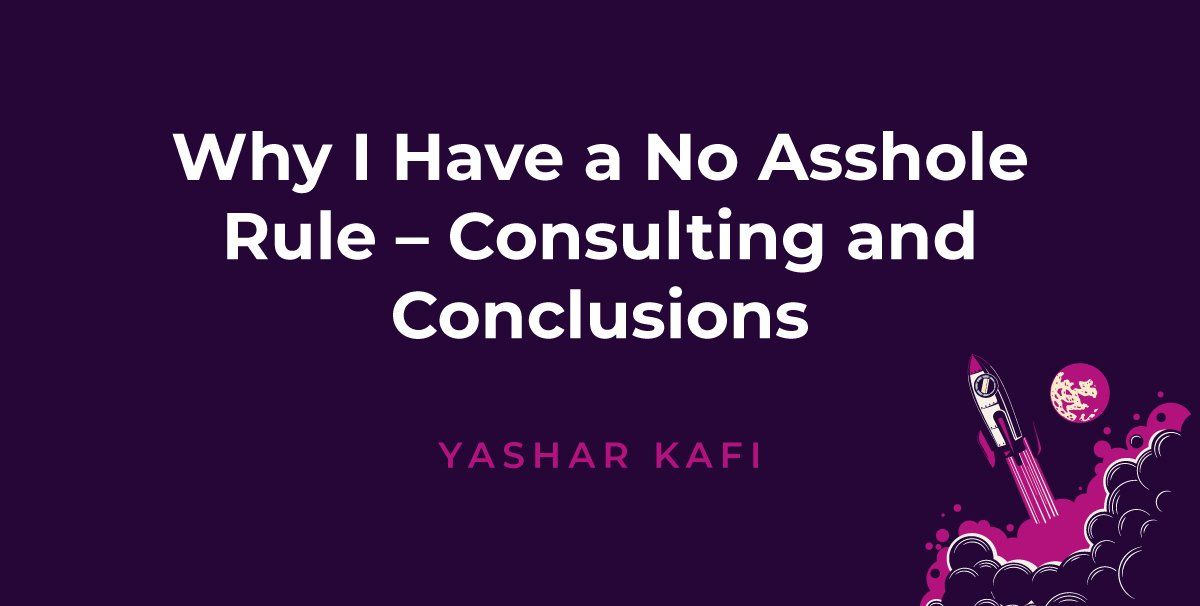Why I Have a No Asshole Rule – Consulting and Conclusions
What I am about to share with you may feel a little controversial, but it’s a belief I stand by. Don’t stand for assholes in business or life.
This mandate has a broad umbrella and covers everyone from clients to employees, even socalled friends and family. Investing energy in any relationship (work or otherwise) with assholes isn’t worth it. Move on when you sense early signs of someone being a jerk (that’s the nice word for it).
Let’s start with the benefits of saying no to those dreaded asshole clients.
Rule 1. No Asshole Clients
We’ve all inevitably heard “the customer is always right” coming up through the ranks of our careers. No individual is always right, and that mindset can damage your appeal and ego. It can even cost you fiscally.
Disrespectful clients not only hurt you (studies show links to depression, anxiety, frustration, and more) but also hurt the bottom line. Rude clients are becoming a norm rather than a rarity these days, sadly. According to a study on the effects of dysfunctional customer behavior on service employees published in the International Journal of Environmental Research and Public Health, 82% of customer-contact employees reported facing rude customers.
The study explains how these interactions are unpleasant and that this unacceptable behavior has a damaging effect on multiple levels: “Deviant behavior of these customers disrupts service encounters, decreases other customers’ overall service satisfaction, and damages the service companies’ financial performance.”
Rule 2. No Asshole Employees
Next on my list is tolerating asshole employees. Who has the bandwidth or energy to deal with jerks in the office? Beyond that, these employees can end up costing you money, not to mention you may feel like a lousy leader. And if you’re a solid leader, you don’t need anyone casting doubt on your leadership in the workplace.
Of course, some people need a helping hand and are rough around the edges—maybe they are just starting or learning a new role. But that isn’t what I’m talking about here. Being new or navigating your way on a corporate learning curve isn’t the same as being a jerk employee.
The workplace is an intense area already, filled with deadlines and goals, etc. There is no room for assholes, as they only add to the pressure and stress and throw the entire workplace culture off, poisoning the well with their poor attitude.
Rule 3. No Asshole Friends
When I think of this third rule—no asshole friends—my mind immediately goes to those “user friends.” I’m talking about the people in your life who always seem to want something from you. Maybe it’s using your friendship as leverage to get a discount on a deal instead of offering to pay full price.
You get the point. It’s the ones who seem to only call you when they need something—the takers.
Rule 4. Keep Bad Family Away
This one is a bit trickier, as you can’t help who you’re related to. However, you don’t need to have toxic family members near your friends, business, or employees. Drawing healthy boundaries in your life and workplace—boundaries banning asshole family members from muddying the waters of other areas in your life by making them inaccessible—will be a true lifesaver for you. Try it.
Consulting and Conclusions
I’ve listed some red flags about toxic or unproductive relationships in consulting. You have to trust your gut to show you when to show these folks the door. You must also rely on instincts to lead you on the right path. So, make decisions quickly—don’t second-guess yourself.
Bottom line: In work and life, we meet all kinds of people. Trusting instincts, drawing conclusions, and avoiding assholes will keep you ahead.
Ready to learn more? Contact us today to get started.




